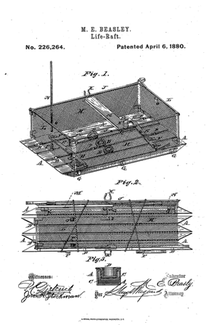Maria Beasley
This article's factual accuracy is disputed. (August 2020) |
Maria Beasley | |
|---|---|
| Born | Maria Kenny 1847 |
| Died | 1904 (aged 56–57) |
| Occupation | Entrepreneur, inventor |
| Known for | Barrel-making machines and improvements to the life raft |

Maria E. Beasley (née Kenny; 1847–1904)[1] was an entrepreneur and inventor. She is best known for her barrel-making machines and her improvements to the life raft.[2] She held fifteen different patents in the United States and two in Great Britain.[3]
Biography[]
Personal life[]
Maria Beasley was born as Maria Kenney in 1847 in Philadelphia, Pennsylvania. Her father was a miller and after her school day was done, Maria often assisted him at the Mill. In 1865, she married a man named Samuel Beasley and changed her name to Maria Beasley. During this time she worked as a dressmaker. Beasley attended the World's Fair in Philadelphia in 1876, which is said to have inspired her to become the innovator she is known for today. She filed over a dozen patents throughout her lifetime, including fifteen in the United States and two in Britain, between the late 1870s to the late 1890s. She died in 1904 at the age of 57.
Career[]
Most of Beasley's inventions were machines that employed her engineering knowledge. Her inventions were diverse, with some of them addressing day-to-day pain points from cooking needs with her patented pots and pans and bread kneader to cold feet with her patented foot warmers. Other of Beasley's inventions included patents that ended up saving lives later on. Several of her inventions involved strides to making transportation safer and more reliable both on ground and in the sea.
Beasley started her career as a dressmaker. Many speculate that she was encouraged to start her career as an engineer and innovator by the Centennial Exposition, more specifically the Women's Pavilion. Over the remainder of her adult career, Beasley filed patents and created numerous innovations.[1] Between the years 1878 and 1898 she filed at least 15 patents.
Her first patent in 1878 was for a barrel hooper, which allowed for an increase in the speed and efficiency of barrel production. With her innovation barrel production could be increased to 1500 per day. It was reported at the time that this invention made her a small fortune. Beasley continued to improve on the barrel making process receiving eight more patents for innovations in this category. Her innovations in barrel making attracted investors from sugar and oil refineries and they paid her a salary of approximately 20,000 dollars annually in contract fees.
Life raft design[]
In 1880, Beasley patented a design for improvement of a life raft.[4] Her improvements to the existing design of the lifeboat ensured that the raft would be airtight to protect any provisions, and also ensured that lowering the boat into the water would be easy and harmless to the boat; her raft was also fire proof. Beasley's life rafts were revolutionary. Prior to her design, life rafts had been flat wooden boards and were unable to fold in half, making storage difficult. Her life raft included metal floats and was much more flexible. Beyond improving the existing hardware, she added two features that were brand new to the design including guard rails.[1] This design would go on to save hundreds of lives in later years. Beasley's life raft was used on the RMS Titanic on its fateful voyage in April 1912. Although there were not enough lifeboats on board to save the 2000-plus passengers aboard the Titanic, the 20 lifeboats that the ship did carry saved the lives of 706 people.[5]
Train designs[]
Another of Beasley's inventions was the steam generator for trains which she patented in 1886, and an anti-derailment device for trains, both of which made train travel safer.
References[]
- ^ Stanley 1995, p. 348.
- ^ Postlethwait, Hannah (Apr 24, 2018). "Maria Beasley: Engineering dynamo". Iowa State University Institute for Transportation. Retrieved June 13, 2021.
- ^ Khan, B. Zorina (2005). The Democratization of Invention: Patents and Copyrights in American Economic Development, 1790-1920. Cambridge: Cambridge University Press. p. 153. ISBN 9780521811354.
- ^ Maria E. Beaslet, Paten No 258191, https://patentimages.storage.googleapis.com/3b/f5/a6/40d112b9a867d1/US258191.pdf
- ^ H. Postlethwait. Maria Beasley: Engineering dynamo https://intrans.iastate.edu/news/maria-beasley-engineering-dynamo/
Citations[]
[1] J. Dray. Maria Beasley, from https://activerain.com/blogsview/5146769/maria-beasleyb
[2] H. Postlethwait. Maria Beasley: Engineering dynamo https://intrans.iastate.edu/news/maria-beasley-engineering-dynamo/
[3] Maria E. Beaslet, Paten No 258191, https://patentimages.storage.googleapis.com/3b/f5/a6/40d112b9a867d1/US258191.pdf
[4] Dray, Maria Beasley.
Sources[]
- Beasley, Maria E. (1882, May 16) Patent No. 258191, retrieved from https://patentimages.storage.googleapis.com/3b/f5/a6/40d112b9a867d1/US258191.pdf
- Dray, J. (2017, December, 10) Maria Beasley, from https://activerain.com/blogsview/5146769/maria-beasleyb
- Irby, T. (2021, March 16) Everyday items you probably didn't know were invented by women, from https://dentonrc.com/business/everyday-items-you-probably-didn-t-know-were-invented-by-women/article_b8168a69-5f1a-59a5-a5e2-04e8f317fceb.html
- Postlethwait, H. (2018, April 24) Maria Beasley: Engineering dynamo https://intrans.iastate.edu/news/maria-beasley-engineering-dynamo/
- "Maria Beasley and Life Rafts". 21st Century Junior Library. https://www.ebooks2go.com/img/samplefiles/9781684445097_Sample.pdf
- "Maria E. Beasley". People Pill.
External links[]
- 19th-century American inventors
- People from Philadelphia
- Women inventors
- Engineers from Pennsylvania
- 1904 deaths
- 1847 births
- 19th-century American businesswomen
- 19th-century American businesspeople